Ijraset Journal For Research in Applied Science and Engineering Technology
- Home / Ijraset
- On This Page
- Abstract
- Introduction
- Conclusion
- References
- Copyright
Effect of Crushed Clay Bricks as Partial Replacement of Fine Aggregate in Concrete of M35 and M40 Grade
Authors: Mudapaka Sreenivas, Dr. Hemant Sood
DOI Link: https://doi.org/10.22214/ijraset.2024.64139
Certificate: View Certificate
Abstract
Concrete is the most material being used in infrastructure development throughout the world. Sand is a prime material used for preparation of mortar and concrete and which plays a major role in mix design. Natural or River sand are weathered and worn-out particles of rock and are of various grades or sizes depending upon the amount of wearing. Now-a-Days good sand is not readily available, it is transported from a long distance. Those resources are also exhausting very rapidly. The non-availability or shortage of river sand, such that excess river erosion and harm to environment is prevented. Many researchers are finding different materials to replace sand. This study aimed to investigate the suitability of using of using crushed clay brick in concrete. Crushed brick originated from demolished masonry was crushed in the laboratory and added partial sand replacement. Eight replacement levels 10%,15%,20%,25%,30%, and 32%, were compared with the control for M35, and M40 design mix concrete grades. The tests on concrete showed that mechanical properties (compressive strength, and split tensile strength) of concrete containing crushed clay brick were well comparable to those of the conventional concrete. The reuse of construction and demolition wastes, especially crushed clay bricks (CCB), represents a major contribution to the environment. Due to the nature of clay bricks, it can be considered as source of fine and coarse aggregates to produce structural concrete. This research has been conducted with the objectives of highlighting the effect of crushed clay bricks as partial replacement of fine aggregate in concrete.
Introduction
I. INTRODUCTION
Concrete is one of the oldest and the most widely used construction material in today’s world. It is easily obtainable, relatively cheap, strong, and durable. On the other hand, the concrete industry is one of the major consumers of the natural resources. The annual concrete production 11 billion metric tons, of which 70-75% are made up of aggregates (mostly natural rock),15% are water, and 10-15% are cementitious binder. Globalisation, privatization, liberalization, and the development of important infrastructure projects have all contributed to the rise in demand for aggregates.
An ecological imbalance has resulted from increased extraction due to the increased demand for natural aggregates’ response, scientists and engineers have looked for fine aggregate substitutes in building. Innovative solutions such as filtered sand, robot silica or sand, treated and sieved silt removed from reservoirs and dams, and sand from other water bodies are among the proposals. The search for substitute materials highlights the importance of both assuring local availability in significant quantities and satisfying the technical specifications of fine aggregates, particularly considering the current need for sustainable infrastructure expansion. This strategy is in line with the main objective of sustainable development, which is to lessen the negative environmental effects of building projects while preserving resources for future generations.
II. SCOPE OF THE STUDY
This paper presents a comprehensive study on the use of brick powder from clay brick demolition wastes in concrete industry. The focus of the research is to present additional information in the field of recycling clay masonry rubbles to explore the possible uses of these recyclable materials in the structural applications. The assessment of different properties of cement pastes and concrete is presented. The current work concludes performance -based guidelines that are imperative from the cost and environmental aspects and that also can be recycled powder in concrete. Brick powder reduces weight of concrete and permeability of concrete.
With the increase in construction activities, there is heavy demand on concrete and consequently on its ingredient like aggregates also. So crushed brick waste can be used as an alternative to this demand.
III. OBJECTIVES OF RESEARCH
- Assessing the Viability of Crushed Brick as a Sand Substitute in Concrete
- Design M35 & M40 grades using conventional fine aggregate
- Design M35 & M40 grades with partial replacement of fine aggregates with variable crushed clay bricks.
- Comparative analysis for properties and cost analysis of manufactured concrete for effective viability in field situation.
- To study various test of concrete to define properties of fresh and hardened concrete by slump test, compressive strength test at 7 days and 28 days, split tensile test at 28 days.
IV. MATERIALS USED
1) Cement: Portland Pozzolana Cement (PPC) confirming to IS1489:part1:2015 was used in the experimentation. Here are some important properties of cement when used in concrete.
Table 1: Properties Of Cement
|
S. No |
Properties |
Results |
|
1 |
Specific Gravity |
3.141 |
|
2 |
Consistency |
32% |
|
3 |
Initial setting Time |
55 min |
|
4 |
Final setting time |
420 min |
|
5 |
Fineness |
2% |
2) Coarse Aggregates: The coarse aggregate use as the crushed stone aggregates which passing through 20mm sieve size and retained on 4.75mm sieve was selected. They have rough, flat surfaces and well-defined angular edges that arise spontaneously. The minimum weight of sample that must be taken for nominal size aggregates for sieving is 2000g, following IS 2386(part I)-2016.To ascertain the gradation, a sieve examination was performed on a sample of 2kg coarse particles.
Table 2: Properties of Coarse aggregates
|
S.No |
Properties |
Results |
|
1 |
Specific gravity |
2.84 |
|
2 |
Water absorption |
0.14% |
|
3 |
Surface moisture |
Nil |
|
4 |
Mass density |
1683 kg/m3 |
3) Fine Aggregates: Aggregate which is passed through 4.75mm IS sieve and retained on 75 micron IS sieve is termed as fine aggregates. The sand used for experimental program was locally procured and confirming to zone-I. The sand was first sieved through 4.75mm sieve to remove any particles greater than 4.75mm.
The fine aggregates were tested as per Indian Standard specification IS:383-1970.Properties of the fine aggregate used in the experimental work are tabulated in table.
Table:3 Properties of Fine Aggregate
|
S.No |
Properties |
Results |
|
1 |
Source of sand |
River |
|
2 |
Specific gravity |
2.33 |
|
3 |
Free surface Moisture |
Nil |
|
4 |
Water absorption |
1.0% |
|
5 |
Fineness modulus |
4.3 |
|
6 |
Grading zone |
I |
4) Crushed Clay Brick: The brick bats crushed in coarse form were used as a fine aggregate for making concrete. The crushed brick powder which is passed 4.75mm IS sieve and retained on 75micron sieve to get the grading of fine aggregate. The crushed clay brick are satisfying the zone-II gradation. The results of various tests conducted on crushed clay brick are given in table
Table:4 Properties of Crushed clay brick
|
S.No |
Properties |
Results |
|
1 |
Specific gravity |
2.1 |
|
2 |
Density |
1862 Kg/m3 |
|
3 |
Fineness modulus |
3.13 |
|
4 |
Water absorption |
1% |
|
5 |
Grading zone |
II |
V. METHODOLOGY
A. Experimental Programme
The aim of the experiment was to assess the properties of concrete made with crushed clay brick and to study the various important aspects such as compressive strength, split tensile strength of concrete prepared by using crushed clay brick with different percentage of replacements with sand. The concrete mix design was proposed using Indian standard method for control concrete as per IS 10262:2019. The grades are M35 and M40.The proportions of materials shown in tables. The replacement levels of sand by brick powder were used in terms of 10%,15%,20%,25%,30% and 32% in concrete
B. Casting of Specimens
To study the effect of replacement of sand in various ratios of crushed clay brick 126 number of cubes of size 150mm for M35 grade,132 numbers of cubes for M40 grade and 66 numbers of cylinders of size 150mmx300mm for M35 grade, and 69 number of cylinders for M40 grade were cast and used as test specimens to determine the compressive strength, and split tensile strength respectively at 7 days and 28 days curing period. Three specimens were tested every time at the required days and mean value was taken. The workability of fresh concrete was measured in terms of slump values. The ingredients of concrete were thoroughly mixed till uniform consistency was achieved by using water reducing admixture named Sika-cim used to get required workability. Cubes, cylinders are compacted on a vibrating table and curing done at nominal temperature.
VI. RESULTS AND DISCUSSIONS
Hardened Concrete Test Results
Compressive strength
Table:5.Trial Mix-I For M35 Grade
|
Replacement of F.A by ccb (%) |
7 days ave. comp. strength in MPa |
28 days ave. comp. strength in MPa |
|
0 |
23.50 |
35.00 |
|
10 |
24.30 |
35.90 |
|
15 |
25.00 |
36.70 |
|
20 |
25.80 |
37.40 |
|
25 |
26.50 |
38.20 |
|
30 |
27.25 |
39.13 |
|
32 |
27.12 |
38.72 |
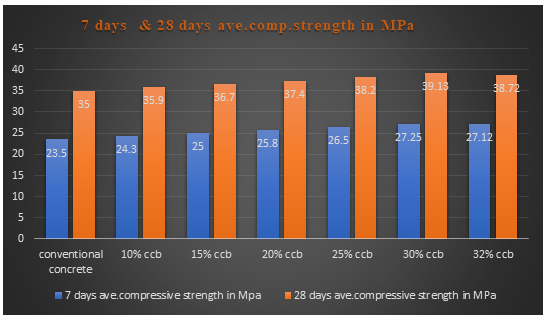
Split tensile strength
Table:6. Trial mix-I for M35 grade
|
S.No |
Replacement of F.A by ccb (%) |
28 days Ave, split tensile strength in MPa |
|
1 |
0 |
3.92 |
|
2 |
10 |
4.28 |
|
3 |
15 |
4.62 |
|
4 |
20 |
5.08 |
|
5 |
25 |
5.25 |
|
6 |
30 |
5.30 |
|
7 |
32 |
4.28 |
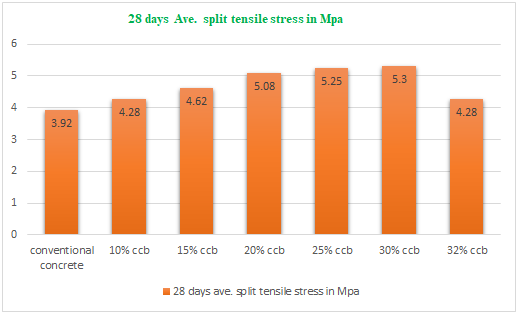
Compressive strength
Table:7.Trial mix-II for M35 grade
|
Replacement of F.A by ccb(%) |
7 days ave. comp.strength in MPa |
28 days ave. comp.strength in MPa |
|
0 |
23.46 |
35.56 |
|
10 |
24.86 |
36.90 |
|
15 |
25.21 |
37.70 |
|
20 |
26.37 |
38.12 |
|
25 |
26.95 |
38.90 |
|
30 |
27.24 |
40.33 |
|
32 |
26.11 |
38.72 |
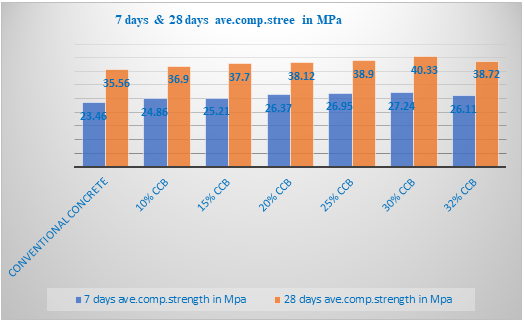
Table:8. 28 days ave. split tensile strength
|
S.No |
Replacement of F.A by CCB in% |
28 days ave. comp. stress in MPa |
|
1 |
0 |
3.62 |
|
2 |
10 |
4.58 |
|
3 |
15 |
5.02 |
|
4 |
20 |
4.78 |
|
5 |
25 |
4.75 |
|
6 |
30 |
4.69 |
|
7 |
32 |
4.28 |

Compressive strength
Table:9.Trial mix-III for M35 grade
|
Replacement of F.A by ccb (%) |
7 days Ave.comp. stress in MPa |
28 days Ave.comp. stress in MPa |
|
0 |
26.50 |
39.21 |
|
10 |
27.30 |
41.29 |
|
15 |
28.40 |
42.57 |
|
20 |
29.65 |
42.84 |
|
25 |
30.25 |
43.26 |
|
30 |
30.69 |
43.33 |
|
32 |
27.45 |
39.12 |

Table:10.28 days ave. split tensile strength in MPa
|
S.No |
Replacement of F.A by CCB (%) |
28 days ave. split tensile strength in MPa |
|
1 |
0 |
4.16 |
|
2 |
10 |
4.85 |
|
3 |
15 |
5.20 |
|
4 |
20 |
5.87 |
|
5 |
25 |
5.95 |
|
6 |
30 |
5.98 |
|
7 |
32 |
4.88 |
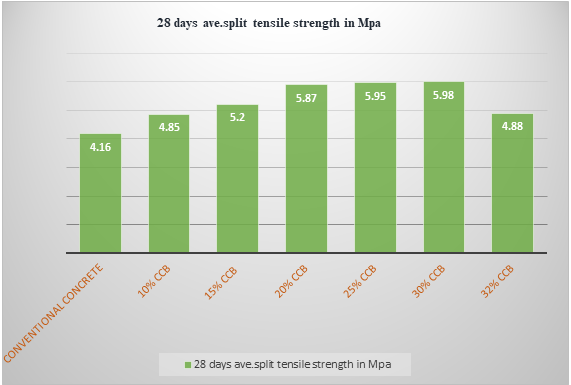
Table:11. Compressive strength for M40 grade
Trial mix-I
|
Replacement of F.A by ccb(%) |
7 days ave. comp.stress in MPa |
28 days ave. comp.stress in MPa |
|
0 |
29.82 |
45.00 |
|
10 |
31.30 |
45.80 |
|
15 |
33.65 |
46.55 |
|
20 |
35.80 |
47.29 |
|
25 |
36.13 |
48.10 |
|
30 |
35.15 |
47.16 |
|
32 |
34.23 |
45.52 |
|
34 |
32.69 |
43.03 |

Table:12. 28-days Ave. split tensile Strength in MPa
|
S.No |
Replacement of F.A by ccb (%) |
28 days ave. split tensile strength in Mpa |
|
1 |
0 |
6.52 |
|
2 |
10 |
6.88 |
|
3 |
15 |
7.12 |
|
4 |
20 |
7.38 |
|
5 |
25 |
7.39 |
|
6 |
30 |
6.41 |
|
7 |
32 |
5.28 |
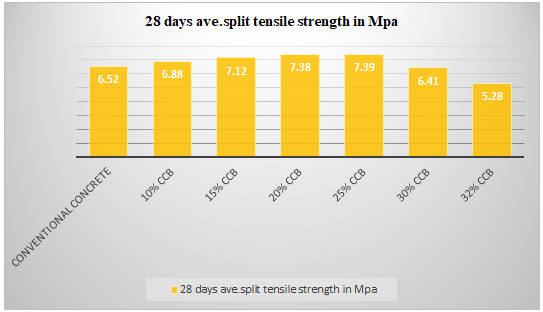
Compressive strength for M40 grade
Table:13.Trial Mix-II
|
Replacement of F.A by ccb(%) |
7 days ave.comp.strength in MPa |
28 days ave.comp.stress in MPa |
|
0 |
28.62 |
43.56 |
|
10 |
30.34 |
44.25 |
|
15 |
32.85 |
44.85 |
|
20 |
33.89 |
45.18 |
|
25 |
34.23 |
45.56 |
|
30 |
32.13 |
44.02 |
|
32 |
31.03 |
42.32 |
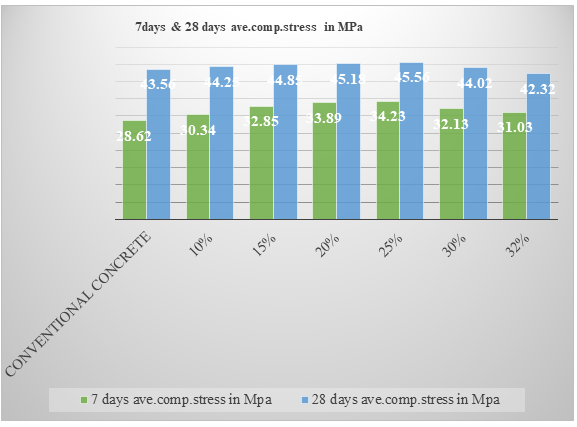
Table:14.28 days ave. split tensile stress in MPa
|
S.No |
Replacement of F.A by ccb(%) |
28 days ave.split tensile strength in MPa |
|
1 |
0 |
5.92 |
|
2 |
10 |
6.28 |
|
3 |
15 |
6.62 |
|
4 |
20 |
7.08 |
|
5 |
25 |
7.10 |
|
6 |
30 |
6.21 |
|
7 |
32 |
6.18 |

Compressive strength for M40 grade
Table:15. Trial mix-III
|
Replacement of F.A by ccb(%) |
7 days ave.comp strength in MPa |
28 days ave.comp. Strength in MPa |
|
0 |
27.32 |
41.23 |
|
10 |
29.04 |
41.95 |
|
15 |
29.75 |
42.05 |
|
20 |
31.29 |
42.88 |
|
25 |
31.83 |
43.12 |
|
30 |
30.45 |
42.02 |
|
32 |
30.03 |
41.62 |

Table:16. 28 days ave. split tensile strength in MPa
|
S.No |
Replacement of F.A by ccb (%) |
28 days ave. split tensile strength in MPa |
|
1 |
0 |
5.28 |
|
2 |
10 |
5.98 |
|
3 |
15 |
6.12 |
|
4 |
20 |
6.38 |
|
5 |
25 |
6.59 |
|
6 |
30 |
5.81 |
|
7 |
32 |
5.32 |
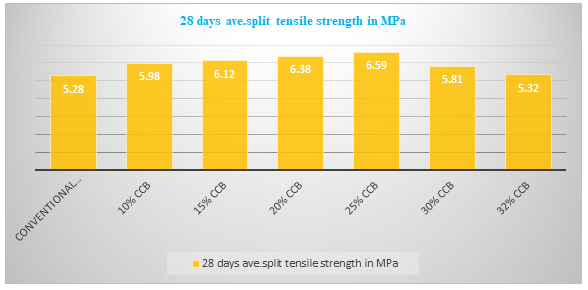
- Effect Of Crushed Clay Brick on Compressive Strength: As per design obtained in accordance to code IS-10262, mix proportion of various materials (viz. cement, sand, coarse aggregate, and water) is calculated for M35, M40 grades of concrete. The cubes were tested in the laboratory in accordance to code IS1343-1980.The results of compressive strength of cubes for 7 and 14 days for various mixes are compared and presented in figs. The compressive strength for 10%,15%,20%,25%,30% and 32% (trial mixes I, II, III) replacement of sand by crushed clay brick were compared with conventional concrete. It is observed that the compressive strength of cubes increases initially up to 30% of replacement of sand by crushed clay brick is 15.96% in 7days strength,11.90% in 28 days. When the percentage of crushed brick increased to 32% reduces strength. For M40 grade of concrete the compressive strength at partial replacement of crushed clay brick up to 25%, increases by 19.09% at 7 days, and 5.35% at 28 days.
- Effect Of Crushed Clay Brick on Split Tensile Strength: The cylinders were tested in the laboratory in accordance to code IS 5816:1999. The results of split tensile strength for 28 days for various mixes are compared and presented in figures. The split tensile strength for 10%,15%,20%,25%,30%, and 32% replacement of cement by crushed clay brick were compared with conventional concrete for M35 and M40 grades... It is observed that the tensile strength (sand partially replaced with ccb) increases initially up to 25% and reduces. In 28 days, test results increase in the value of 36.72% for M35 grade of concrete and 19.36% for M40 grade.
Conclusion
Based on the experimental study investigating the use of crushed clay brick in concrete as a partial replacement of fine aggregate, the following conclusions which are limited to the materials used in the study. The compressive strength and split tensile strength of concrete with crushed clay brick as a partial replacement of fine aggregates increase as the w/c ratio is increased up to 0.415. 1) The compressive strength and split tensile strength increase when crushed clay brick replaces fine aggregate up to a maximum of 30%; after that, they decrease for M35 grade concrete. 2) The compressive strength and split tensile strength increase when crushed clay brick replaces fine aggregates up to maximum of 0 to 25% after they decrease for M40 grade concrete. 3) Compared to conventional concrete, concrete that has had some of its fine aggregate replaced with crushed clay brick (CCB) has a higher density. 4) No voids form after testing concrete cubes and cylinders along failure surfaces, which results in the concrete becoming impermeable. 5) The heat of hydration is lower when mixing concrete, which is beneficial for increasing strength and reducing shrinkage. 6) It is an affordable and feasible way to dispose of brick waste safely. 7) Crushed clay brick (CCB) is the most suitable substitute for fine aggregate in concrete due to its cementitious and silicious qualities.
References
[1] Ali A. Aliabdo a , Abd-Elmoaty M. Abd-Elmoaty a, *, Hani H. Hassan‘’Utilization of crushed clay brick in concrete industry’’ Alexandria University, , Alexandria Engineering Journal Egypt. Received 14 November 2013; revised 11 December 2013; accepted 15 December 2013 Available online 13 January 2014. [2] Davoud Tavakoli1*, Ali Heidari2 and Sasan Hayati Pilehrood3‘’Properties of Concrete made with Waste Clay Brick as Sand Incorporating Nano SiO2.’’. Indian Journal of Science and Technology, Vol 7(12), 1899–1905, December 2014 [3] M. Usha Rani J. Martina Jenifer ‘’An Experimental Study on Partial Replacement of Sand with Crushed Brick in Concrete’’. IJSTE-International Journal of Science Technology & Engineering | Volume 2 | Issue 08 | February 2016 ISSN (online): 2349-784X. [4] Diniya David, Bindu Sebastian , Minu Anna Johny ‘’Partial Replacement of Fine Aggregate with Crushed Clay Brick in Cellular Concrete’’. International Journal of Innovative Research in Science, Engineering and Technology (An ISO 3297: 2007 Certified Organization) Website: www.ijirset.com Vol. 6, Issue 5, May 2017 [5] A.Siva1*, Thamilselvi P1 , A. Nisha Devi1 and B.Ashvini1. ‘’Experimental Investigation on Partial Replacement of Fine Aggregate Using Crushed Spent Fire Bricks’. American Journal of Engineering Research (AJER) 2017 American Journal of Engineering Research (AJER).e-ISSN:2320-0847p-ISSN:2320-0936,Volume-6,Issue-2pp-01-04,www.ajer.org,Open Access. [6] O M Olofinnade1 , J I Ogara1 , I T Oyawoye1 , A N Ede1 , J M Ndambuki2 , K D Oyeyemi3 and D O Nduka. ‘’Mechanical properties of high strength eco-concrete containing crushed waste clay brick aggregates as replacement for sand’’.1st International Conference on Sustainable Infrastructural development Conference Series: Materials Science and Engineering 640(2019)012046 doi:10.1088/1757-899X/640/1/012046. [7] Satish R.Parmar1,Chetan G.Solanki2. Performance evaluation of concrete with partial replacement of over burnt brick aggregate Vol-5 Issue -2 2019 IJARIIE-ISSN(O)-2395-4396. [8] Mohd Ishaq Hassan , Sandeep Nasier. ‘’Partial Replacement of Sand in Mortar by Brick Dust and Saw Dust’’. International Journal of Innovative Technology and Exploring Engineering (IJITEE) ISSN: 2278-3075 (Online), Volume-9, Issue-7, May 2020. [9] Duaa Jabbar Abdullah, Dr. Zena K Abbas, Dr. Suhair kadhem abed.‘’Study of Using of Recycled Brick Waste (RBW) to produce Environmental Friendly Concrete’’: A Review. Journal of Engineering journal homepage: www.joe.uobaghdad.edu.iq Number 11 Volume 27 November 2021. [10] Hussein Al-kroom, May M. Atyia, Mohamed G. Mahdy and Mohamed Abd Elrahman. ‘’The Effect of Finely-Grinded Crushed Brick Powder on Physical and Microstructural Characteristics of Lightweight Concrete’’ minerals MDPI [11] Rani Hude1 , Trupti Bhasme , Avirat Dhodare3 , Prajwal Mahure4 , Rahul Sonwane , Toshil Goswami6 , Prof. G.D. Dhavale, 8Ms. P. B. Gadge. ‘’Utilization of Surkhi as a Partial Replacement of Sand in Concrete’’ May 2022 | IJIRT | Volume 8 Issue 12 | ISSN: 2349-6002. [12] Gaspard Ukwizagira1*, Bienvenu Nezerwa2 & Habimana Umukunzi George Bush3. ‘’Effect of Crushed Clay Brick as Partial Replacement of Fine Aggregate in Concrete’’ Mediterranean Journal of Basic and Applied Sciences (MJBAS) Volume 7, Issue 1, Pages 90-99, January-March 2023. [13] IS:456-2000-Code of practice for plain and reinforced concrete. [14] IS:10262-2019-Concrete mix proportioning-Guidelines. [15] IS:383-2016-Code for coarse and fine aggregate for concrete.
Copyright
Copyright © 2024 Mudapaka Sreenivas, Dr. Hemant Sood. This is an open access article distributed under the Creative Commons Attribution License, which permits unrestricted use, distribution, and reproduction in any medium, provided the original work is properly cited.

Download Paper
Paper Id : IJRASET64139
Publish Date : 2024-09-02
ISSN : 2321-9653
Publisher Name : IJRASET
DOI Link : Click Here
 Submit Paper Online
Submit Paper Online

